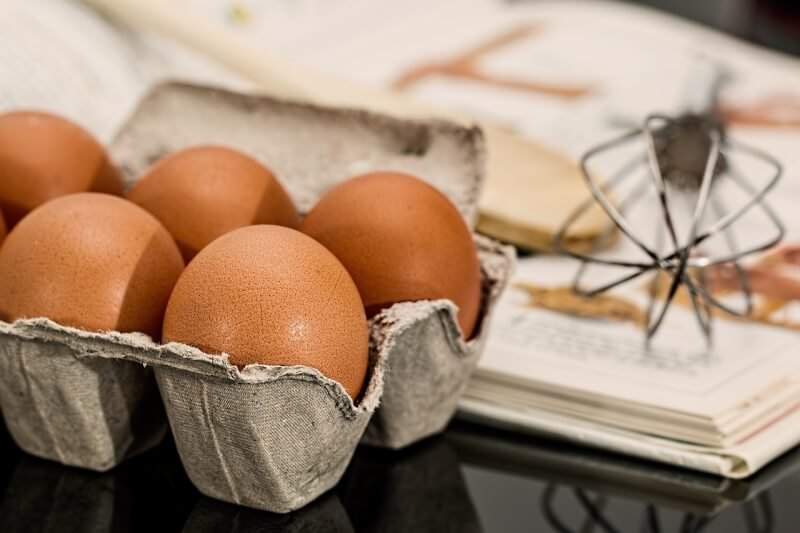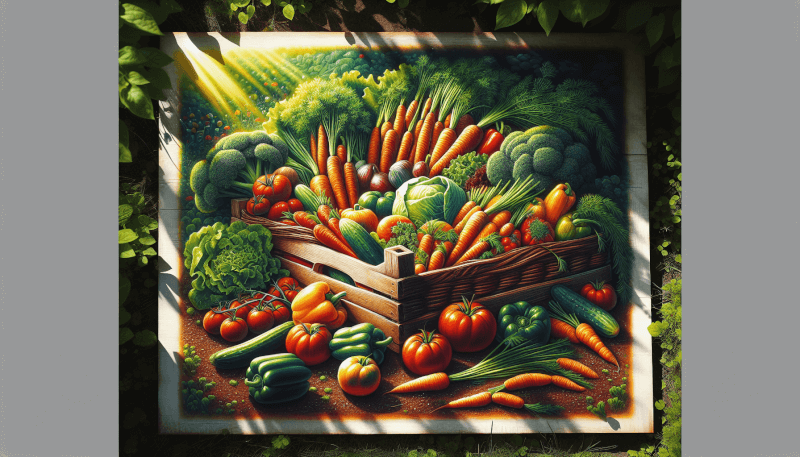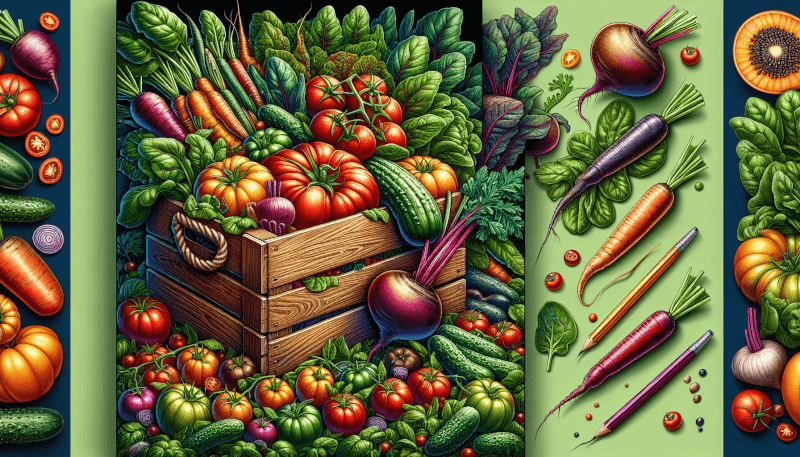Are you looking to create a healthy and delicious garden recipe plan? Look no further! In this article, we will guide you through the process of designing a meal plan that utilizes fresh ingredients from your garden. From selecting the perfect vegetables to incorporating them into nutritious and flavorful recipes, we will provide you with all the tips and tricks you need to create a garden recipe plan that will leave you feeling satisfied and nourished. So grab your gardening gloves and get ready to dig in!

Choose a Variety of Vegetables and Fruits
When creating a healthy garden recipe plan, it’s important to choose a variety of vegetables and fruits. By incorporating a range of colors and types of produce, you can ensure that you are getting a wide array of nutrients. Different colors in fruits and vegetables indicate the presence of various phytochemicals and antioxidants, which are beneficial for your health. For example, red and orange produce are rich in beta-carotene, while dark leafy greens are packed with vitamins A, C, and K. By including a mix of different types of fruits and vegetables in your garden, you can create a beautiful and nutritious meal.
Consider Different Colors and Types of Produce
When choosing the vegetables and fruits for your garden, it’s important to consider different colors and types of produce. Not only does this add variety to your meals, but it also ensures that you are getting a wide range of nutrients. For example, orange-colored produce such as carrots and sweet potatoes are rich in beta-carotene, which is converted to vitamin A in the body and is important for good vision. Green leafy vegetables like spinach and kale are rich in vitamins A, C, and K, as well as folate. By including a mix of colors and types of produce in your garden, you can ensure that you are meeting your nutritional needs.
Select Seasonal and Local Produce
Choosing seasonal and local produce is not only beneficial for the environment but also for your health. Seasonal produce is harvested at its peak ripeness, which means it is fresher and more flavorful. Additionally, seasonal produce is often more affordable and readily available. Local produce is grown closer to home, which means it spends less time in transit and on store shelves, resulting in a higher nutrient content. When planning your garden, consider the vegetables and fruits that grow well in your area during different seasons. By opting for seasonal and local produce, you can support local farmers and enjoy the benefits of fresh, healthy food.
Include Both Cooked and Raw Fruits and Vegetables
Including both cooked and raw fruits and vegetables in your garden recipe plan is important to maximize the nutritional benefits. While eating raw produce can provide you with essential vitamins and minerals, cooking certain vegetables can enhance their flavor, texture, and nutrient availability. For example, cooking tomatoes increases the bioavailability of lycopene, a powerful antioxidant. On the other hand, eating raw cruciferous vegetables like broccoli and cauliflower ensures that you get the maximum amount of the enzyme myrosinase, which plays a role in cancer prevention. By including a mix of raw and cooked fruits and vegetables in your garden, you can enjoy a wide range of flavors and maximize the nutritional benefits of your meals.

Incorporate Protein-Rich Foods
In addition to fruits and vegetables, it’s important to incorporate protein-rich foods into your garden recipe plan. Protein is an essential macronutrient that is important for building and repairing tissues, supporting immune function, and providing energy. There are several plant-based sources of protein that you can grow in your garden, such as legumes (beans, lentils, peas), nuts, and seeds. For example, growing beans provides you with a versatile source of protein that can be used in a variety of dishes, from salads to soups. By incorporating protein-rich foods into your garden recipe plan, you can ensure that you are meeting your daily protein needs and enjoying a well-rounded and balanced diet.
Ensure an Adequate Intake of Whole Grains
Including whole grains in your garden recipe plan is essential for a healthy and balanced diet. Whole grains provide a range of nutrients, including fiber, B vitamins, and minerals. They are also a good source of complex carbohydrates, which provide a steady release of energy throughout the day. Examples of whole grains that you can grow in your garden include quinoa, amaranth, and millet. These grains can be used in a variety of dishes, such as salads, soups, and side dishes. By ensuring an adequate intake of whole grains in your garden recipe plan, you can promote digestive health, reduce the risk of chronic diseases, and maintain a balanced diet.

Include Healthy Fats
Healthy fats are an essential component of a healthy garden recipe plan. They provide energy, promote satiety, and aid in the absorption of fat-soluble vitamins. Examples of healthy fats that you can grow in your garden include avocados, olives, and nuts. Avocados are rich in monounsaturated fats, which have been shown to support heart health. Olives are a great source of monounsaturated fats as well, along with antioxidants. Nuts are packed with healthy fats, fiber, and various nutrients. By including healthy fats in your garden recipe plan, you can add flavor and texture to your dishes while supporting your overall health.
Opt for Organic and Pesticide-Free Options
When planning your garden, it’s important to opt for organic and pesticide-free options. Organic produce is grown without the use of synthetic fertilizers, pesticides, and genetically modified organisms (GMOs). By choosing organic produce, you can reduce your exposure to harmful chemicals and promote a healthier environment. Additionally, organic produce is often higher in nutrients compared to conventionally grown produce. When purchasing seeds or seedlings for your garden, look for organic options. By opting for organic and pesticide-free options in your garden, you can contribute to a healthier and more sustainable food system.

Purchase Organic Produce
One way to ensure that you are getting organic produce is to purchase it from local farmers or farmers’ markets. Many local farmers follow organic farming practices but may not be certified organic due to the high costs involved. By buying directly from local farmers, you can support sustainable agriculture and have confidence in the quality of the produce you are purchasing. Local farmers’ markets also provide an opportunity to connect with growers, learn about their farming practices, and even get gardening tips. When purchasing organic produce, you can be confident that you are making a choice that is both healthy for you and beneficial for the environment.
Avoid GMOs and Synthetic Pesticides
Genetically modified organisms (GMOs) and synthetic pesticides have raised concerns about their potential impact on human health and the environment. GMOs are plants or animals whose genetic material has been altered in a way that does not occur naturally. They are often engineered to be resistant to pests or herbicides, which can lead to increased pesticide use. Synthetic pesticides, on the other hand, are chemicals that are used to control pests. They can have negative effects on human health and the environment, including the depletion of beneficial insects and the contamination of water sources. By avoiding GMOs and synthetic pesticides, you can reduce your exposure to potentially harmful substances and support sustainable agricultural practices.

Consider Growing Your Own Produce
One of the best ways to ensure that your produce is organic and pesticide-free is to consider growing your own. By growing your own fruits and vegetables, you have full control over the growing methods and can ensure that you are using organic practices. This allows you to have fresh, nutritious, and delicious produce right at your fingertips. Gardening can also be a rewarding and stress-relieving activity that allows you to connect with nature and enjoy the beauty of your backyard. Whether you have a large garden or just a small balcony, there are many options for growing your own produce. Consider starting with herbs, greens, or easy-to-grow vegetables like tomatoes and peppers. By growing your own produce, you can take pride in the food you eat and promote a healthier lifestyle.
Plan Your Garden Layout
When creating a garden recipe plan, it’s important to consider the layout of your garden. This includes factors such as available space, climate, and the types of vegetables and fruits you want to grow. By planning your garden layout, you can optimize the use of space, ensure that your plants have the proper conditions to thrive, and make harvesting and maintenance easier. Here are some considerations for planning your garden layout:
Consider the Available Space
First, assess the available space you have for your garden. This includes both the size and shape of the area. Consider whether you have a large backyard, a small balcony, or even just a sunny window sill. Take measurements and visualize how the garden will fit into the space.
Choose the Right Vegetables and Fruits for Your Climate
Next, consider the climate in your area. Different vegetables and fruits thrive in different climates, so it’s important to choose plants that are well-suited to your environment. Research which crops are best suited for your region and when the optimal planting times are. This will ensure that your plants have the best chance of success.
Allocate Separate Areas for Different Plants
When planning your garden layout, consider allocating separate areas for different plants. Group plants with similar watering needs together to make irrigation easier. Leave enough space between plants to allow for proper airflow and prevent the spread of diseases. By organizing your garden in this way, you can optimize the use of space and create an organized and efficient growing environment.
Create a Planting Schedule
To ensure a successful garden, it’s important to create a planting schedule. This involves determining the best time to plant each crop, considering the concept of succession planting for a continuous harvest, and using companion planting techniques to enhance growth. Here’s how to create a planting schedule:
Determine the Best Time for Planting Each Crop
Research the optimal planting times for the vegetables and fruits you want to grow. This information can usually be found on seed packets or in gardening books and websites. Consider factors such as the length of the growing season, frost dates, and the temperature requirements of each crop. By planting at the right time, you can maximize the chances of success for each plant.
Consider Succession Planting for Continuous Harvest
Succession planting involves staggering the planting of crops to ensure a continuous harvest throughout the growing season. Instead of planting all of your seeds or seedlings at once, plant small batches at regular intervals. This way, you can enjoy a steady supply of fresh vegetables and fruits without being overwhelmed all at once.
Use Companion Planting to Enhance Growth
Companion planting is a method that involves planting certain crops together to benefit each other. Some plants have natural properties that repel pests or attract beneficial insects. By planting compatible crops together, you can help create a more balanced ecosystem in your garden. For example, planting basil near tomatoes can help repel pests and improve tomato flavor. Do some research on companion planting to find out which plants go well together and which should be kept apart.
Prepare the Soil for Planting
Before planting your fruits and vegetables, it’s important to prepare the soil to provide the best growing conditions. This includes testing the soil pH levels, adding organic matter and compost, and maintaining proper moisture levels. Here’s how to prepare the soil for planting:
Test the Soil pH Levels
Soil pH levels can affect the availability of nutrients to your plants. Most vegetables and fruits grow best in slightly acidic to neutral soil, with a pH range of 6 to 7. You can test the pH of your soil using a soil testing kit or by sending a sample to a soil testing laboratory. If your soil pH is too low (acidic) or too high (alkaline), you can make adjustments by adding amendments such as lime or sulfur.
Add Organic Matter and Compost
Adding organic matter and compost to your soil improves its structure, fertility, and moisture-holding capacity. Organic matter can be in the form of well-rotted compost, aged manure, or leaf mold. Spread a layer of organic matter over the top of your soil and then work it in, using a garden fork or tiller. This will help improve the health of your soil and provide a nutrient-rich environment for your plants.
Maintain Proper Moisture Levels
Proper moisture levels are essential for the health and growth of your plants. Most vegetables and fruits require consistent moisture, but not waterlogging. Use your finger to check the moisture level of the soil. If it feels dry, it’s time to water. Mulching around your plants with organic material, such as straw or wood chips, can help retain moisture in the soil and reduce weed growth. Regularly monitor the moisture levels in your garden and make adjustments as needed.
Implement Sustainable Gardening Practices
When creating a garden recipe plan, it’s important to implement sustainable gardening practices. This involves practicing water conservation, composting kitchen scraps and yard waste, and using natural pest control methods. By implementing sustainable gardening practices, you can minimize your environmental impact and create a more resilient and self-sufficient garden. Here’s how to implement sustainable gardening practices:
Practice Water Conservation
Water is a precious resource, so it’s important to practice water conservation in your garden. Use mulch to help retain moisture in the soil, and water your plants in the early morning or late evening to reduce evaporation. Consider installing a rain barrel to collect rainwater for irrigation. Also, choose drought-tolerant plant varieties that require less water. By using water wisely in your garden, you can minimize waste and promote a sustainable garden.
Compost Kitchen Scraps and Yard Waste
Composting is a great way to reduce waste and create nutrient-rich soil for your garden. Collect kitchen scraps, such as fruit and vegetable peelings, coffee grounds, and eggshells, in a compost bin or pile. Also, add yard waste, such as grass clippings and leaves. Over time, these organic materials will break down into compost, which can be used to enrich your soil. By composting kitchen scraps and yard waste, you can reduce landfill waste and provide a sustainable source of nutrients for your garden.
Use Natural Pest Control Methods
Instead of relying on synthetic pesticides, consider using natural pest control methods in your garden. Encourage beneficial insects, such as ladybugs and lacewings, by planting flowers that attract them. Use physical barriers, such as row covers or netting, to protect your plants from pests. Rotate your crops each season to reduce the build-up of pests and diseases. By using natural pest control methods, you can maintain a healthy garden ecosystem and avoid the harmful effects of synthetic pesticides.
Harvest and Store Your Produce Properly
When it’s time to harvest your fruits and vegetables, it’s important to do so at optimal ripeness and store them properly to maintain their quality and nutritional value. Here are some tips for harvesting and storing your produce:
Pick Vegetables and Fruits at Optimal Ripeness
Harvest your vegetables and fruits when they are at their optimal ripeness. This will ensure that they are at their peak flavor and nutritional content. For example, tomatoes are best picked when they are fully ripe and have developed their full color. On the other hand, leafy greens like lettuce and spinach can be harvested when the leaves are mature but still tender. Be sure to research the specific harvesting guidelines for each plant in your garden.
Store Produce in the Correct Conditions
After harvesting, store your produce in the correct conditions to maximize its shelf life. Some fruits and vegetables, such as tomatoes and peppers, can be stored at room temperature. Others, like leafy greens and herbs, should be stored in the refrigerator to maintain their freshness. Use proper storage containers, such as breathable bags or containers with ventilation, to prevent moisture build-up and spoilage. Be mindful of the ideal storage conditions for each type of produce to ensure it stays fresh for as long as possible.
Maintain Good Food Safety Practices
Good food safety practices are essential when handling and storing produce. Wash your hands thoroughly before handling fruits and vegetables. Clean all tools and surfaces that come into contact with produce to prevent contamination. Ensure that your storage containers are clean and free from any residue. Also, be vigilant for signs of spoilage or mold and discard any produce that is past its prime. By maintaining good food safety practices, you can reduce the risk of foodborne illnesses and keep your garden-fresh produce safe to consume.
Keep Track of Your Gardening Successes
To improve your gardening skills and maximize the success of your garden recipe plan, it’s important to keep track of your gardening successes. Document your garden plan and planting dates, record the yield and quality of produce, and make notes on what works and what doesn’t. Here’s how to keep track of your gardening successes:
Document Your Garden Plan and Planting Dates
Start by documenting your garden plan and planting dates. This can be as simple as drawing a garden map and making notes on what vegetables and fruits you have planted and where. Note down the planting dates for each crop and any specific requirements, such as trellising or staking. This will help you keep track of your garden’s progress and ensure that you are planting at the appropriate times.
Record Yield and Quality of Produce
Throughout the growing season, record the yield and quality of your produce. Keep track of how much you harvest and any variations in flavor or texture. This will help you assess which crops are the most productive and which might need some adjustments in your gardening practices. By documenting the yield and quality of your produce, you can make informed decisions for future garden plans.
Make Notes on What Works and What Doesn’t
Lastly, make notes on what works and what doesn’t in your garden. Did a specific variety of tomato perform exceptionally well? Was there a particular pest that caused problems? Keeping a garden journal allows you to reflect on your successes and challenges, enabling you to fine-tune your approach each season. Share your knowledge with other gardening enthusiasts and learn from their experiences as well.
Experiment with Garden-to-Table Recipes
Finally, once your garden has produced a bountiful harvest, it’s time to experiment with garden-to-table recipes. There’s no better way to enjoy the fruits of your labor than by creating delicious meals with your homegrown produce. Here are some ideas for experimenting with garden-to-table recipes:
Take Advantage of Fresh Herbs and Spices
Fresh herbs and spices from your garden can elevate the flavors of your dishes. Experiment with different combinations of herbs, such as basil, rosemary, and thyme, to add aromatic notes to your recipes. Use fresh spices, like cumin or paprika, to enhance the depth of flavor in your dishes. Incorporate herbs and spices into salads, marinades, soups, and sauces for a fragrant and delicious garden-to-table experience.
Explore Different Cooking Techniques and Styles
When cooking with your garden produce, don’t be afraid to explore different cooking techniques and styles. Roasting, grilling, sautéing, and steaming can bring out unique flavors and textures in your vegetables and fruits. Try different recipes and cuisines to broaden your culinary horizons. For example, stir-fry your homegrown vegetables with a blend of Asian spices or grill your fresh fruit for a sweet and smoky dessert. The possibilities are endless when it comes to garden-to-table cooking!
Share Your Culinary Creations with Others
Finally, don’t forget to share your culinary creations with others. Invite friends and family over for a garden-inspired feast or host a potluck where everyone brings a dish featuring their own garden produce. Share your recipes and cooking tips with others who may be inspired to start their own garden. By sharing your garden-to-table journey with others, you can spread the joy of gardening and inspire others to embrace a healthy and sustainable lifestyle.
In conclusion, creating a healthy garden recipe plan requires careful consideration of a variety of factors. Choosing a variety of vegetables and fruits, incorporating a balanced mix of nutrients, opting for organic and pesticide-free options, planning your garden layout, creating a planting schedule, preparing the soil for planting, implementing sustainable gardening practices, harvesting and storing your produce properly, keeping track of your gardening successes, and experimenting with garden-to-table recipes are all essential components of a comprehensive garden recipe plan. By following these guidelines and putting in the effort to tend to your garden, you can enjoy the satisfaction of growing your own food and creating nutritious and delicious meals from scratch. Happy gardening and happy cooking!

